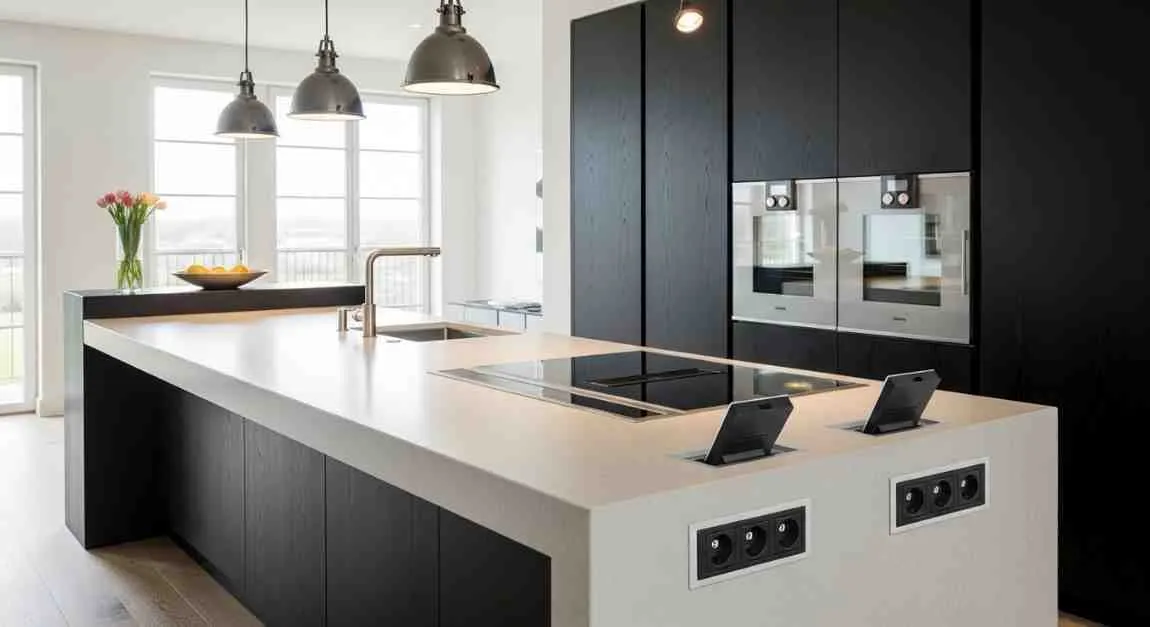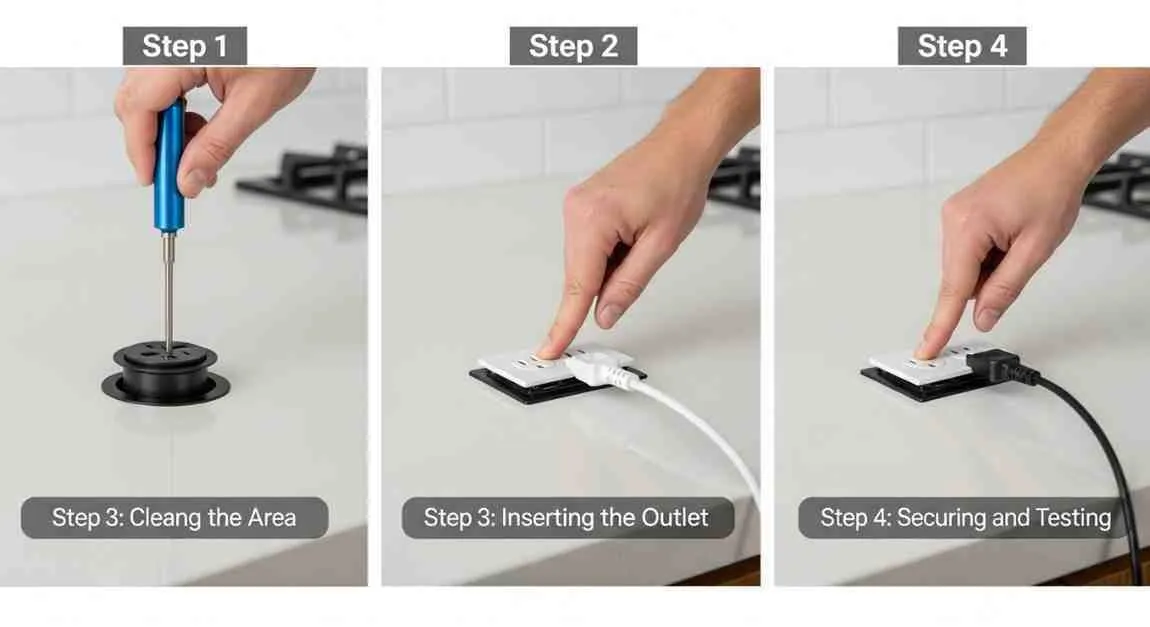Introduction: The Kitchen Island Dilemma That Stumped a Homeowner
Sarah Martinez was halfway through her dream kitchen renovation when her contractor delivered unexpected news: “We need to talk about outlets in your kitchen island.” She’d carefully planned every detail—the butcher block countertop, the farmhouse sink, the pendant lighting—but electrical outlets hadn’t crossed her mind. Her contractor explained that recent changes to the National Electrical Code had implications for her island design, and the decisions she made now would affect both functionality and compliance.
Sarah’s situation isn’t unique. Across the country, homeowners and contractors are navigating updated requirements for outlets in kitchen islands, trying to balance code compliance with aesthetic preferences and practical needs. The 2023 National Electrical Code (NEC) introduced changes that affect how kitchen islands are wired, where outlets can be placed, and what provisions must be made for future electrical needs.
Whether you’re planning a kitchen remodel, building a new home, or simply curious about electrical code requirements, understanding the rules governing outlets in kitchen islands is essential. This comprehensive guide explains the latest NEC 2023 changes, explores placement options that satisfy both inspectors and designers, and provides practical advice for creating a kitchen island that’s safe, functional, and code-compliant.
Understanding the National Electrical Code and Kitchen Islands
What Is the NEC and Why Does It Matter?
The National Electrical Code, published by the National Fire Protection Association (NFPA), establishes the foundation for electrical safety in residential, commercial, and industrial settings across the United States. While the NEC itself isn’t federal law, most states and local jurisdictions adopt it as the basis for their electrical codes, sometimes with modifications to address regional concerns.
The code undergoes revision on a three-year cycle, with the most recent edition being NEC 2023. These updates reflect advances in technology, lessons learned from electrical accidents and failures, and evolving understanding of electrical safety. For homeowners, this means that requirements for electrical installations change periodically, and what was acceptable during your last renovation might not meet current standards.
Why Kitchen Islands Receive Special Attention
Kitchen islands present unique electrical challenges. Unlike perimeter countertops backed by walls that can easily house electrical boxes and provide stable mounting surfaces, islands are freestanding structures. Running power to them requires careful planning, and installing outlets in ways that maintain both safety and aesthetics requires thoughtful design.
The kitchen environment adds another layer of complexity. It’s a high-traffic area where water, heat, sharp objects, and electrical appliances coexist. Children play nearby, pets wander through, and adults work with wet hands while cooking. These factors make electrical safety in kitchens particularly critical, and kitchen islands—where outlets might face away from walls and be more accessible to children or vulnerable to water exposure—deserve special consideration.
The Evolution of Island Outlet Requirements
Historically, the NEC’s approach to kitchen island outlets has evolved significantly. Earlier code versions didn’t specifically address islands, leaving interpretation to local jurisdictions and inspectors. As islands became standard features in American kitchens, the need for clear, consistent guidance became apparent.
Previous code cycles introduced requirements for island outlets, then refined them as practical experience revealed implementation challenges. The NEC 2023 represents the latest iteration of these requirements, addressing concerns raised by builders, electricians, inspectors, and homeowners about previous code language.
NEC 2023 Kitchen Island Outlet Requirements: What Changed
The Key Code Section: 210.52(C)(2)
The primary code section governing outlets in kitchen islands is NEC 210.52(C)(2), which addresses receptacle outlets for countertop surfaces. Understanding this section is crucial for anyone planning kitchen island electrical work.
Under NEC 2023, the code distinguishes between island countertops where receptacles are required and those where they’re optional but must have provisions for future installation. The specific requirements depend on the island’s dimensions and configuration.
When Outlets Are Required
According to NEC 2023, receptacle outlets are required on island countertops that have a long dimension of 24 inches or greater and a short dimension of 12 inches or greater. If your island meets these dimensional thresholds, you must install at least one receptacle outlet to serve the countertop surface.
This requirement reflects the recognition that islands of this size will likely be used for food preparation, small appliance operation, or other tasks requiring electrical power. Requiring outlets ensures homeowners have convenient access to electricity without stretching cords across the kitchen or creating trip hazards.
The Future Provision Requirement
One of the significant changes in recent NEC editions involves islands that don’t meet the dimensional thresholds requiring immediate outlet installation. Even if your island is too small to require a receptacle outlet now, NEC 2023 mandates that you provide for future installation.
This “future provision” means installing infrastructure—typically conduit, junction boxes, or both—that would allow a receptacle to be added later without major renovation work. The rationale is straightforward: kitchen needs change over time, and what seems adequate today might prove insufficient tomorrow. By requiring provisions for future outlets, the code ensures homeowners can adapt their kitchens without tearing into walls, floors, or cabinets.
The future provision must terminate in an accessible location where a receptacle could reasonably be installed. This might be inside a cabinet beneath the island, in a basement or crawl space below the kitchen, or in another accessible area that would allow for outlet installation without structural modifications.
GFCI Protection Requirements
All receptacles serving kitchen countertop surfaces, including those on islands, must have ground-fault circuit-interrupter (GFCI) protection under NEC 2023. This requirement isn’t new, but it’s worth emphasizing because GFCI protection is critical for safety in areas where water and electricity might interact.
GFCI devices detect imbalances in electrical current that indicate electricity is taking an unintended path—potentially through a person—and shut off power within milliseconds. In kitchens, where wet hands, spills, and water sources are common, GFCI protection can prevent serious injury or death from electrical shock.
GFCI protection can be provided through GFCI receptacles at each outlet location or through GFCI circuit breakers that protect all outlets on a particular circuit. Both approaches are code-compliant; the choice often depends on cost considerations, ease of testing, and installer preference.

Outlet Placement Options for Kitchen Islands
Side-Mounted Outlets: The Traditional Approach
Side-mounted outlets installed on the vertical face of an island have been the standard solution for decades. These outlets meet code requirements while keeping the countertop surface uninterrupted for work and presentation.
When installing side-mounted outlets, placement considerations include height above the floor, distance from the countertop edge, and positioning relative to seating areas and cabinet doors. The code specifies that outlets serving countertop surfaces must be located within 24 inches of the countertop surface, measured vertically. This ensures they’re accessible for countertop appliance use while preventing cords from draping excessively.
Side-mounted outlets work well functionally but can present aesthetic challenges, especially in open-concept kitchens where the island is visible from multiple angles. Designers often try to position these outlets on the least visible face of the island or integrate them into decorative elements to minimize visual impact.
Pop-Up and Countertop-Mounted Outlets
Pop-up outlets offer an alternative that preserves the island’s visual lines when outlets aren’t in use. These devices mount flush with or slightly below the countertop surface, then extend upward when needed. When closed, pop-up outlets are nearly invisible, maintaining the island’s clean appearance.
Several varieties of pop-up outlets exist. Some feature spring-loaded mechanisms that pop up when pressed, while others require manual lifting and rotating to lock in the raised position. More sophisticated models include tamper-resistant receptacles, USB charging ports, and finishes that match kitchen hardware.
Pop-up outlets present both advantages and challenges. On the positive side, they preserve countertop aesthetics and can be positioned exactly where they’re most convenient. However, they’re more expensive than standard receptacles, can interfere with countertop work when extended, and may be more vulnerable to spills and debris than wall-mounted alternatives.
Installation requires careful attention to waterproofing and protection against moisture intrusion, as these devices penetrate the countertop surface. Quality pop-up outlets include gaskets and seals designed to prevent water from reaching electrical components, but proper installation is critical for maintaining these protections.
Under-Counter Outlets: Meeting Code While Staying Hidden
Some designers and electricians advocate for outlets installed beneath the island countertop overhang, facing outward. This approach can satisfy code requirements—depending on interpretation and local jurisdiction—while keeping outlets completely hidden from view when not in use.
Under-counter outlets work particularly well when the island includes seating, as the outlets face the seating area and are easily accessible to anyone sitting at the island. This placement is practical for charging devices or powering small appliances used by people seated at the island.
However, this placement can be controversial from a code perspective. Some jurisdictions and inspectors question whether under-counter outlets truly “serve the countertop surface” as the code intends, since they don’t facilitate the use of appliances directly on the countertop. Before planning this approach, consult with your local building department to confirm it will pass inspection in your area.
Drawer Outlets: An Innovative Solution
An increasingly popular approach involves installing outlets inside drawers, particularly in islands with deep drawers designed for storage. These outlets allow devices to charge inside the drawer, keeping cords and chargers out of sight while maintaining accessibility.
Drawer outlets are particularly useful for charging stations, where phones, tablets, and other devices can charge inside a closed drawer without cluttering the countertop. Some systems include built-in organizers that hold devices upright while charging, maximizing drawer space efficiency.
From a code compliance perspective, drawer outlets can be tricky. If the drawer outlet is intended to serve the countertop surface requirement, inspectors may question whether it meets the code’s intent. However, drawer outlets can work well as supplementary receptacles in addition to code-required countertop-serving outlets, providing extra functionality beyond minimum requirements.
Design Considerations: Balancing Aesthetics and Function
Integrating Outlets Without Compromising Design
Modern kitchen design emphasizes clean lines, uninterrupted surfaces, and carefully curated aesthetics. Standard electrical outlets, with their utilitarian appearance, can feel like compromises in thoughtfully designed spaces. Fortunately, multiple strategies can minimize outlets’ visual impact while maintaining code compliance and functionality.
Color matching represents the simplest approach. Outlets and cover plates are available in numerous finishes beyond standard white and ivory, including stainless steel, bronze, black, and even custom colors. Selecting outlets that match or complement your island’s finish helps them blend into the design rather than standing out as foreign elements.
Strategic positioning also reduces visual impact. Placing outlets on the island’s least visible face—often the back side away from main traffic patterns—makes them less noticeable during normal use. When multiple outlets are required, distributing them around the island’s perimeter rather than clustering them in one location can make each individual outlet less prominent.
Architectural integration offers another approach. Some designers incorporate outlets into decorative trim, molding, or panel details that are architectural features in their own right. When done well, outlets become part of a larger design element rather than afterthoughts attached to an otherwise finished surface.
USB and Specialty Outlets
Modern outlets offer functionality beyond standard 120-volt receptacles. Combination outlets that include both traditional receptacles and USB charging ports are increasingly popular in kitchens, where phones, tablets, and other devices frequently need charging.
USB outlets reduce countertop clutter by eliminating the need for plug-in charging adapters. Some models include USB-C ports alongside standard USB-A ports, providing compatibility with newer devices. Higher-end options offer quick-charging capability that delivers power faster than standard USB ports.
When selecting USB outlets for kitchen islands, ensure they’re rated for the environment and include necessary safety features. All outlets serving countertop surfaces still require GFCI protection, and any USB outlet used in this application should be listed for kitchen use by a recognized testing laboratory.
Cord Management and Safety
Even with ideally placed outlets, appliance cords can create visual clutter and safety hazards. Thoughtful cord management improves both aesthetics and safety.
For frequently used appliances that remain on the countertop, consider positioning outlets to minimize visible cord length. Routing cords behind canisters, decorative elements, or the appliances themselves keeps them less visible. Some homeowners install outlets at different heights to allow cords to drop directly behind appliances without excess length pooling on the countertop.
Cord clips, channels, and organizers can help manage cords for appliances used regularly but not constantly. These accessories route cords neatly along the island’s base or edge, preventing tangling and keeping cords off the floor where they create trip hazards.
For islands with seating areas, pay particular attention to cord management. Outlets placed for counter seating convenience can create situations where charging cords hang at exactly the wrong height for people seated at the island. Consider outlets with built-in cord management features or plan for discrete places where cords can be secured when not in use.
Electrical Inspection and Code Compliance
What Inspectors Look For
When electrical inspectors examine kitchen island outlet installations, they verify multiple aspects of code compliance. Understanding their priorities helps ensure your installation passes inspection on the first attempt.
First, inspectors verify that outlets are present where required based on the island’s dimensions. They’ll measure the island to confirm it meets the thresholds triggering outlet requirements and check that the required number of outlets has been installed in compliant locations.
Second, inspectors examine outlet placement and mounting. They check that outlets serving countertop surfaces are positioned within the code-specified distance from the countertop, that they’re properly secured, and that cover plates are installed correctly. For pop-up or specialty outlets, inspectors may verify that they’re listed for kitchen use and installed according to manufacturer specifications.
Third, GFCI protection will be tested. Inspectors use GFCI testers to verify that outlets have proper ground-fault protection and that the protection functions correctly. They may also check that GFCI devices are labeled appropriately and that test buttons and reset buttons are accessible.
Fourth, for islands where future provisions are required instead of immediate outlet installation, inspectors verify that adequate infrastructure exists. This means checking that conduit has been installed to an accessible location, that junction boxes are properly positioned and accessible, and that the provision would actually allow for future outlet installation without major renovation work.
Common Mistakes to Avoid
Several common errors can cause kitchen island outlet installations to fail inspection or create safety hazards:
Incorrect outlet placement: Installing outlets outside the code-specified distance from the countertop surface is a frequent violation. Some installers misunderstand the measurement requirements or fail to account for countertop overhang when positioning boxes during rough-in.
Missing GFCI protection: While rare in new construction, forgotten GFCI protection occasionally occurs, particularly in retrofit situations where existing circuits are extended to serve new islands. Every outlet serving kitchen countertop surfaces requires GFCI protection—no exceptions.
Inadequate future provisions: When provisions for future outlets are required, some installations include minimal effort that doesn’t actually facilitate future outlet installation. A piece of conduit that terminates in an inaccessible location doesn’t satisfy the code’s intent. Provisions should be genuine—able to support outlet installation without requiring demolition or major work.
Improper outlet types: Using standard outlets in locations requiring tamper-resistant receptacles, or using outlets not rated for the installation environment, can result in violations. Kitchen island outlets should be tamper-resistant and appropriate for the installation method (standard wall boxes, pop-up enclosures, etc.).
Circuit overloading: While not strictly an island-specific issue, failing to properly calculate circuit loads when adding island outlets can create problems. Kitchen small appliance circuits have specific requirements, and adding island outlets to inappropriate circuits can violate code provisions.
Working with Local Jurisdictions
While the NEC provides national standards, local jurisdictions may adopt the code with amendments or interpretations that affect island outlet requirements. Before finalizing plans, verify requirements with your local building department.
Some jurisdictions are more prescriptive about outlet placement than others. Some may require specific numbers of outlets based on island length, while others may accept minimal compliance. Some jurisdictions may interpret code provisions about outlet placement more or less strictly than neighboring areas.
Building relationships with local inspectors can smooth the inspection process. Electricians who regularly work in an area develop understanding of local interpretations and preferences. If you’re serving as your own general contractor or doing electrical work yourself in jurisdictions that permit it, consider scheduling a preliminary consultation with the inspector to review plans before starting work.

Real-World Applications: Case Studies
Case Study 1: The Modern Minimalist Kitchen
When architect James Chen designed a contemporary kitchen for clients prioritizing clean aesthetics, the island outlet requirement posed a design challenge. The clients wanted an uninterrupted waterfall countertop wrapping the island’s ends, and visible outlets would compromise the minimalist aesthetic.
Chen’s solution incorporated motorized pop-up outlets with brushed metal finishes matching the kitchen’s hardware. The outlets install flush with the quartz countertop, completely invisible when retracted. When needed, a gentle press releases the spring-loaded mechanism, and the outlet rises approximately four inches above the surface.
The installation required careful coordination between the electrician and countertop fabricator. Precise cutouts in the quartz accommodated the outlet housings, with waterproof seals preventing moisture intrusion. Junction boxes mounted in the cabinet below provided access for connections and future service.
The result satisfied code requirements while maintaining the desired aesthetic. The clients report that they rarely need to extend the outlets—most countertop appliances are used near the perimeter where wall outlets are accessible—but the island outlets provide essential backup for situations requiring power away from walls.
Case Study 2: The Family-Friendly Island
The Rodriguez family’s kitchen remodel prioritized child safety alongside functionality. With three children under ten, they wanted island outlets positioned where young children couldn’t easily access them while maintaining convenience for adult use.
Their designer specified outlets mounted on the island’s side facing the kitchen perimeter, positioned 10 inches above the floor—well below the countertop surface but above the reach of toddlers sitting or crawling. All outlets included tamper-resistant mechanisms preventing insertion of foreign objects.
Additionally, the island included a charging drawer with outlets inside, allowing parents to charge devices out of children’s reach. This supplementary feature didn’t count toward code requirements but provided practical value for the family’s needs.
The installation passed inspection without issues. The inspector appreciated the thoughtful approach to child safety while maintaining code compliance. The family reports that the outlet positioning works well in practice, keeping cords off the floor while remaining accessible when needed.
Case Study 3: The Retrofit Challenge
When Maria Santos purchased a 15-year-old home with a kitchen island, she discovered the island had no electrical outlets—a code violation by current standards but potentially compliant when originally built. Planning a minor kitchen refresh, she needed to bring the island up to current code without major renovation.
Her electrician assessed the situation and determined that running new circuits from the main panel would require cutting through finished flooring—an expensive and disruptive proposition. Instead, they identified an existing kitchen circuit with adequate capacity and planned to extend it to the island.
The solution involved running electrical wire through the basement below the kitchen, then up through the island’s base cabinet. Side-mounted outlets on two faces of the island provided the required countertop service. GFCI protection was added at the circuit’s origin point, protecting all outlets on the extended circuit.
The work required two days and cost significantly less than Maria had budgeted, expecting more extensive renovations. The island now meets current code requirements, providing convenient power for countertop appliances and charging devices. Maria’s experience illustrates that bringing older kitchens up to current standards isn’t always as disruptive or expensive as homeowners fear.
Practical Installation Tips
Planning for Rough-In
Success with kitchen island outlets begins during the rough-in phase, before cabinets, countertops, and finishes are installed. Careful planning at this stage prevents problems during finish work.
First, verify island dimensions and final placement. Islands sometimes shift position slightly during construction as other elements are installed. Confirm the island’s exact location before running electrical lines and installing boxes, as repositioning after rough-in is costly and time-consuming.
Second, coordinate with other trades. Plumbing lines for island sinks, gas lines for cooktops, and HVAC ducting can all conflict with electrical components. A coordination meeting among plumber, electrician, and HVAC contractor before rough-in begins can prevent conflicts and rework.
Third, consider access for future service. Outlet boxes should be positioned where they’ll remain accessible after cabinets are installed. Junction boxes for future provisions should be truly accessible—inside cabinets with removable backs, in accessible basement spaces, or in other locations where future work is realistic.
Fourth, account for countertop thickness and overhang. The final height of outlets serving countertops depends on the substrate, countertop material thickness, and any buildup used during installation. Coordinate with the countertop installer to verify final dimensions before positioning outlet boxes during rough-in.
Selecting Quality Components
Not all electrical outlets are created equal, and quality differences matter particularly in kitchen environments where moisture, heat, and frequent use stress components.
For side-mounted outlets, specify commercial-grade or specification-grade receptacles rather than residential-grade options. These higher-quality outlets include stronger mounting straps, more robust internal contacts, and better construction that extends service life. The cost difference is minimal—typically just a few dollars per outlet—but the reliability improvement is significant.
For GFCI receptacles, select models from established manufacturers with strong reputations for reliability. GFCI devices include sensitive electronics that must function correctly to provide protection. Bargain-priced GFCI outlets may not provide the consistent protection that quality devices deliver.
For pop-up outlets, research thoroughly before purchasing. Read reviews from installers and homeowners, verify that models include adequate waterproofing, and confirm compatibility with your countertop material. Some pop-up outlets work better with specific materials, and selecting the wrong model can lead to installation difficulties or poor performance.
DIY vs. Professional Installation
Electrical work in kitchens involves both safety considerations and code compliance requirements. While some homeowners have the skills to handle electrical installations, others should hire licensed electricians.
Consider professional installation if you’re unfamiliar with electrical codes, uncomfortable working with electrical systems, or uncertain about any aspect of the work. Licensed electricians understand code requirements, have experience with inspections, and carry liability insurance protecting you from problems resulting from faulty work.
If you choose DIY installation in jurisdictions that permit homeowner electrical work, educate yourself thoroughly before beginning. Study the relevant NEC sections, review your local amendments, and consider consulting with the building inspector before starting work. Many inspectors appreciate homeowners who ask questions in advance rather than correcting violations after work is complete.
Regardless of who performs the work, obtain necessary permits and schedule required inspections. Unpermitted electrical work creates liability issues, complicates future home sales, and may void insurance coverage in the event of electrical fires or other problems.
Frequently Asked Questions
Are outlets required on a kitchen island under NEC 2023?
Yes, outlets are required on kitchen islands that have a long dimension of 24 inches or greater and a short dimension of 12 inches or greater. Islands meeting these dimensional thresholds must have at least one receptacle outlet serving the countertop surface. Islands smaller than these dimensions don’t require immediate outlet installation but must include provisions—such as conduit or junction boxes—that facilitate future outlet installation without major renovation.
Can I install side outlets on my island?
Yes, side-mounted outlets installed on the vertical faces of kitchen islands are code-compliant and represent the most common approach to meeting island outlet requirements. These outlets must be positioned within 24 inches of the countertop surface, measured vertically, to properly serve countertop appliances. Side-mounted outlets should include GFCI protection and tamper-resistant mechanisms as required by current code provisions.
Do kitchen island outlets need GFCI protection?
Yes, all receptacle outlets serving kitchen countertop surfaces, including those on islands, require ground-fault circuit-interrupter (GFCI) protection under NEC 2023. This protection can be provided through GFCI receptacles at each outlet location or through GFCI circuit breakers protecting all outlets on the circuit. GFCI protection is essential for safety in kitchen environments where water and electricity may interact.
How high should a countertop outlet be mounted?
For outlets serving countertop surfaces, including kitchen island outlets, the NEC requires mounting within 24 inches of the countertop surface when measured vertically. This distance ensures outlets remain accessible for countertop appliance use while preventing excessively long or dangling cords. Many installers position outlets approximately 4 to 10 inches above the floor when measuring from a standard 36-inch counter height, though the exact height depends on countertop thickness and overhang.
What is the best outlet placement for aesthetics and safety?
The optimal outlet placement balances code compliance, safety considerations, and design preferences. Side-mounted outlets on the island’s least visible face maintain clean countertop surfaces while satisfying code requirements. Pop-up outlets offer superior aesthetics but cost more and require careful waterproofing. Under-counter outlets can work well near seating areas if permitted by local jurisdiction. The best choice depends on your kitchen’s layout, how you use the island, and whether visible outlets conflict with your design goals. Consulting with both an electrician and a designer helps identify solutions meeting all priorities.
What does “future provision for outlet” mean?
A future provision means installing infrastructure—typically electrical conduit, junction boxes, or both—that would allow a receptacle outlet to be added later without major renovation work. This requirement applies to kitchen islands that don’t meet the dimensional thresholds requiring immediate outlet installation. The provision must terminate in an accessible location where an outlet could reasonably be installed in the future, such as inside a cabinet beneath the island or in a basement or crawl space below the kitchen. The goal is ensuring homeowners can add outlets as needs change without tearing into walls, floors, or finished surfaces.
Are pop-up outlets code compliant?
Yes, pop-up outlets can be code-compliant when properly selected and installed. They must be listed for the intended use by a recognized testing laboratory, include required safety features such as GFCI protection and tamper-resistant mechanisms, and be installed according to manufacturer specifications. Pop-up outlets must include adequate waterproofing to protect electrical components from spills and moisture. When these requirements are met, pop-up outlets represent a code-compliant alternative to traditional side-mounted outlets, offering aesthetic advantages in kitchens where visible outlets conflict with design goals.
Can I use the same circuit for island outlets and other kitchen outlets?
Kitchen small appliance circuits have specific requirements under the NEC. Generally, at least two 20-ampere small appliance branch circuits must serve kitchen countertop outlets, and these circuits cannot serve other areas. Island outlets can share circuits with other kitchen countertop outlets if the circuit has adequate capacity and meets code requirements. However, careful calculation of potential loads is essential to avoid overloading circuits. Many electricians prefer dedicating separate circuits to islands, particularly large islands with multiple outlets, to ensure adequate capacity and prevent nuisance breaker trips. Consult with a licensed electrician to determine appropriate circuit configuration for your specific situation.

Conclusion: Powering Your Kitchen Island Safely and Stylishly
Outlets in kitchen islands represent the intersection of electrical safety, building codes, and design aesthetics. The NEC 2023 changes reflect ongoing efforts to ensure kitchens remain safe while accommodating evolving cooking habits and appliance use. Understanding these requirements helps homeowners, builders, and designers create islands that are both beautiful and compliant.
The key takeaways for kitchen island outlets include recognizing when outlets are required versus when future provisions suffice, understanding the various placement options available, ensuring GFCI protection for all countertop-serving outlets, and coordinating electrical planning with overall kitchen design early in the renovation or building process.
Whether you’re building a new home or renovating an existing kitchen, the decisions you make about island outlets affect both immediate functionality and long-term flexibility. Outlets positioned thoughtfully serve current needs while adapting to changing requirements. Infrastructure installed properly facilitates future modifications without major renovation.
Code requirements might seem restrictive, but they exist to protect your family from electrical hazards while ensuring your kitchen remains functional. Working within these parameters, skilled designers and electricians create islands that are stunning to look at and safe to use—combining form and function in ways that enhance your home.
As you plan your kitchen island, invest time in understanding the electrical requirements, explore the various outlet options available, and consult with qualified professionals who can help you achieve your vision while maintaining code compliance. The result will be a kitchen island that serves your family safely for years to come, with electrical access precisely where you need it and aesthetics that make you proud.
Get Expert Guidance for Your Kitchen Project
Planning a kitchen renovation or building a new home? Share your questions about kitchen island outlets in the comments below. Our community includes homeowners, contractors, and designers who can offer insights from their experiences.
Want more kitchen planning resources? Subscribe to our newsletter for guides covering everything from layout design to material selection, helping you create the kitchen of your dreams. Internal link: Subscribe to Our Home Improvement Newsletter (dofollow)
Need help with code compliance? Check out our comprehensive guide to Internal link: Understanding Electrical Codes for Kitchen Remodeling (dofollow) for detailed information about NEC requirements affecting your entire kitchen renovation.
Ready to dive deeper into the NEC? Visit the External link: National Fire Protection Association (nofollow) for official information about the National Electrical Code and access to the complete code text.
Looking for qualified electricians? Consult the External link: National Electrical Contractors Association (nofollow) to find licensed electrical contractors in your area who understand current code requirements and can ensure your kitchen island outlets are installed correctly.
Found this guide helpful? Share it with friends planning kitchen projects, post it to your favorite DIY or home improvement communities, and help spread accurate information about kitchen electrical requirements. Together, we can create safer, more functional kitchens across the country.



